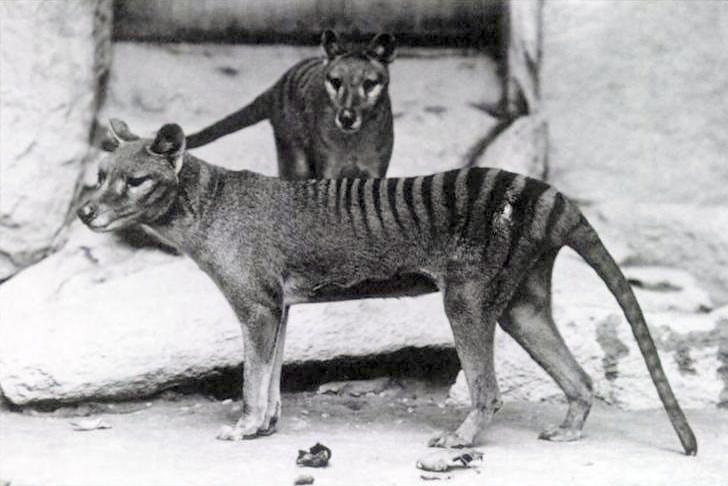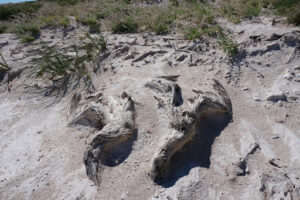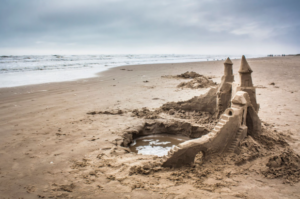Extinction happens. In fact, it happens pretty regularly.
On average, ‘the background extinction rate’ will bump off about one species, per million species, per year. But what we’re seeing now is a bit more extreme.
“If we look at the numbers of just mammal extinctions on the continent [Australia] in the last 200 years, they’ve been extraordinary,” said Professor Trish Fleming, a wildlife conservation expert from Murdoch University.
Since Europeans colonised Australia, at least 40 species of terrestrial mammal have gone extinct. That rate is around 600 times faster than the normal background extinction rate, and there are lots of species that we might not even realise have perished.
“We actually have no comprehension of the amount of biodiversity that we have. There’s a whole wealth of things like isopods, spiders and stygofauna, that we never even think about or consider,” said Trish.
So, is this a mass extinction?
Since life began, there have been five occasions where more than three-quarters of all species went extinct within 2.8 million years. These calamities have been used to establish a benchmark for what constitutes a mass extinction: 75% of species gone in 2.8 million years.
Obviously, we haven’t quite run out the clock for this era to officially qualify, but with extinction rates hundreds of times higher than ‘normal’, it’s hard to view what’s happening as anything else.
“I definitely do think what we’re experiencing is a mass extinction”, said Trish.
“We keep removing resources and changing and altering habitat in ways that are irreversible…we’re taking resources away that we can’t conceivably replace within our lifetimes.”
Addressing ‘Big Problems’
So how are we supposed to feel about living in a ‘mass extinction event’?
Scared? Maybe.
Frustrated? Probably.
Confused? Definitely.
Conversations around climate change and biodiversity loss are happening on a greater scale than ever before. But when it seems like everything is a crisis, it can be overwhelming.
Donna Houston is a professor of Environmental Humanities at Macquarie University, and studies how people discuss and tell stories about social and environmental challenges.
“We’re living in this time of profound environmental change and biodiversity loss that has been caused by humans… it does raise a lot of ethical questions about how we relate to the environment”, said Donna.
“The cultural response can be a sense of hopelessness sometimes, or a sense of loss; loss of place, or loss of ways of life. So, it’s important to keep that hopeful narrative alive.”
The sheer volume of information we receive about environmental issues can be disorienting. Where are we even supposed to start? Part of the challenge is in creating language to encompass the scope of what we’re facing.
The ‘Anthropocene’ is used to describe the period where human impact has been the dominant influence on the Earth. Though it was recently rejected as a formal geological term, ‘Anthropocene’ and other terms like it, serve a valuable function by encapsulating the environmental narrative.
“From a social science perspective, it has been useful to communicate the concept of the world we’re in, in terms of climate change, biodiversity loss, and mass extinctions, and to generate the action that needs to happen at a global scale”, said Donna.
Of course, not all people have contributed to these problems equally, and ‘Anthropocene’ is sometimes critisised for lacking nuance. But using the right language can help to remind us that we’re in this crisis together.
THERE’S NO ‘I’ IN ‘THE END OF THE WORLD’
We all want to make a difference in helping to prevent extinction and climate change, but what is “making a difference” when the issues are so large?
If I stop eating red meat, don’t fly for the next 10 years, plant native trees in my garden and take my keep-cup to the cafe, will that be enough?
“We talk a lot about emissions budgets and renewable technologies, and it becomes really technical conversation for bureaucrats and corporations to sort out”, said Dr Blanche Verlie from the University of Sydney.
Blanche’s research looks at the lived experience of climate change. She studies how people experience the distress of environmental issues, and what drives environmental action.
“The reason people don’t do anything is not because they don’t care. It’s because they don’t know what to do, and the actions that are suggested most of the time are like pissing in the wind”, said Blanche.
One of the major cultural narratives is the idea of being an environmentally conscious consumer. That, if we can choose to buy the right products, it will help to change things.
“That’s not bad to do, but it’s never going to be enough. People end up going down this really time consuming rabbit hole of trying to evaluate every single product. It’s a lifelong task, and it’s excruciating”, said Blanche.
Individual actions are great, especially for motivation, but there’s a limit to how much a single person can do. The real difference is made when we act as a collective.
“Building communities and helping people find collectives and networks is much more important”, said Blanche.
“The distinguishing factor between people feeling motivated or overwhelmed…is whether they live in communities where they feel able to take meaningful action.”
The greatest change comes from having a collective voice and taking collective action. Vive la révolution!
“You don’t need to be in some position of power or from some elite background to have an important voice on the issue. The people whose voices matter, are the people who are most affected”, said Blanche.
“Our leaders could and should be doing a lot more. Given that they are not, one of the most powerful things that we can do is to hold them accountable.”
NO “UNDO BUTTON”
We might be experiencing a mass extinction event, but that doesn’t mean the story’s over. Remember, a mass extinction occurs over 2.8 million years, so there’s a little time left.
“We can’t reverse the clock. It would be great to have an undo button, but we don’t. We have to try and push the tide back a bit…if we’re going to prevent further extinction”, said Trish.
Doing that requires many individual actions contributing towards a collective movement.
“It’s seriously challenging but at the same time, you know ‘from little things, big things grow’. Those smaller acts are accumulative, and they do mean something at the end of the day”, said Donna.
But more than anything, living in a mass extinction means connecting with people around us and realising we’re not alone. This is an experience we’re sharing, and that means the solutions are something we’re going to share as well.
“Don’t get disappointed or disillusioned about it. I’m sure we’re going to make a difference, so we better just jolly well try”, said Trish.













